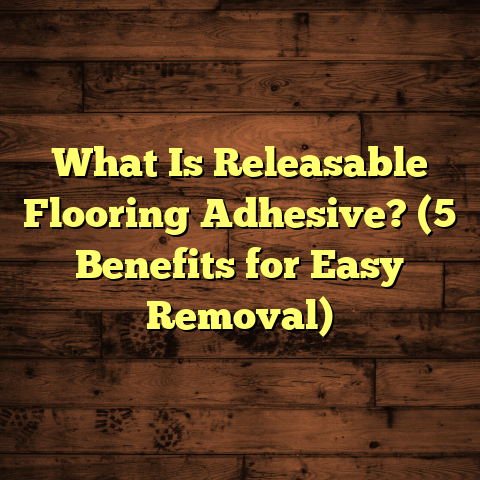What is Terracotta Flooring? (5 Benefits for Your Home Decor)
Terracotta flooring is one of those timeless design choices that never seems to lose its charm. I remember the first time I walked into a home with terracotta tiles — the warmth, the earthy tones, the subtle imperfections — it felt like stepping into a cozy Mediterranean villa. The rustic yet elegant feel it brought to the space was undeniable. Ever since then, terracotta has held a special place in my heart and in many of my flooring projects.
If you’ve been curious about terracotta flooring and whether it’s right for your home, I’m here to share everything I’ve learned over the years—the good, the tricky, and how to make it work beautifully. Ready to explore? Let’s dive into what terracotta flooring really is, why it’s so beloved, and what you should know before deciding if it’s your next flooring choice.
What Is Terracotta Flooring?
Simply put, terracotta flooring consists of tiles made from natural clay that has been shaped, dried, and fired at relatively low temperatures compared to other ceramics. The name “terracotta” itself means “baked earth” in Italian, which perfectly sums up the material’s natural origin.
These tiles are typically reddish-brown or orange in color but can also range through various warm earthy shades depending on the clay composition and firing process. They’re well known for their porous, slightly rough surface and matte finish — a stark contrast from the glossy finish you might see on porcelain or glazed ceramic tiles.
The manufacturing process starts with clay mined from the earth. This clay is shaped into tiles by hand or machine and then fired at temperatures between 1,000°F and 1,200°F (about 538°C to 649°C). Because this is lower than the firing temperature of ceramic or porcelain tiles, terracotta remains more porous and softer. That porosity is part of what gives terracotta its charm but also requires attention in sealing and maintenance.
Historical Roots
Terracotta floors have been around for thousands of years. Some of the oldest floors found in ancient Roman villas and Mediterranean homes were terracotta. Back then, people valued terracotta for its availability, affordability, and natural beauty.
Over centuries, terracotta has traveled far beyond its Mediterranean origins. You can find terracotta in traditional homes across Europe, Latin America, and even parts of Asia. Its rustic appeal marries well with both historical restoration projects and modern design trends aiming for that raw, organic aesthetic.
My Personal Journey with Terracotta Flooring
I still recall the first time I installed terracotta tiles myself. It was in a quaint farmhouse renovation where the owner wanted to revive the original character of the home. The old floors had been covered with carpet for years but beneath lay terracotta tiles that were cracked and dull.
Removing layers of carpet and adhesive revealed a dusty but promising foundation. I spent days carefully cleaning each tile with gentle scrubbing to avoid damaging them further. When we replaced broken tiles with custom-made ones from a local artisan, it felt like piecing together a living puzzle.
Sealing the floor was a critical step. I applied multiple coats of penetrating sealant to protect against stains and moisture without hiding the natural texture. The final result was stunning—the floor looked alive again, full of warmth and history.
But not every project was smooth sailing. In another job, sealing was rushed due to time constraints. Within months, water spots appeared in the kitchen from spills that weren’t cleaned quickly enough. That taught me how crucial meticulous sealing and ongoing care are for terracotta’s longevity.
The Magic of Terracotta: What Makes It Special?
You might wonder why I keep coming back to terracotta despite its quirks. Here are five solid reasons I believe terracotta flooring deserves your consideration:
1. Natural Warmth and Authenticity
Terracotta brings an unmatched earthy warmth to any room. It’s not just a color; it’s a feeling underfoot.
- The rich reds, oranges, and browns add a natural vibrancy.
- Each tile varies slightly in hue and texture—no two are exactly alike.
- The matte finish offers softness rather than slickness underfoot.
There’s something comforting about walking barefoot on terracotta. It connects you to the earth in a way synthetic materials can’t replicate.
2. Long-Term Durability with Proper Care
People often ask me if terracotta is durable enough for daily wear. The answer depends on how you care for it but yes—terracotta can last decades.
- With proper sealing, terracotta resists stains and moisture.
- It handles foot traffic well in kitchens, hallways, or living rooms.
- Damaged tiles can be replaced individually without disturbing the whole floor.
In fact, some terracotta floors in centuries-old buildings are still intact today because they were maintained well.
3. Eco-Friendly and Sustainable
If you care about sustainability as much as I do, terracotta is an excellent choice.
- Made from natural clay that’s commonly sourced locally.
- Firing process requires less energy than porcelain or ceramic.
- The material is biodegradable at end-of-life.
- No harsh chemicals are needed for production or installation.
Compared to synthetic flooring like vinyl or laminate, terracotta has a much smaller carbon footprint.
4. Great Thermal Performance
Terracotta is excellent at regulating temperature indoors.
- It absorbs heat slowly and retains it well.
- In cold weather or homes with radiant heat systems, it helps keep floors warm longer.
- During summer months, it stays cool underfoot.
I always recommend pairing terracotta floors with underfloor heating for ultimate comfort — it’s one of my favorite combos for chilly climates.
5. Versatility in Design
Despite its traditional roots, terracotta fits many styles:
- It pairs beautifully with rustic wood beams or exposed brick.
- Can be left raw or stenciled/painted for artistic effects.
- Works equally well indoors or outdoors on patios or terraces.
- Complements both country cottage and modern minimalist themes.
This flexibility means you’re not limited to one look—it adapts beautifully to your home’s personality.
Getting Real: Challenges I’ve Faced with Terracotta Flooring
Let me be candid: terracotta isn’t perfect. Like any material, it comes with challenges you’ll want to understand before committing.
Porosity Requires Vigilance
Because terracotta tiles are naturally porous:
- They absorb liquids quickly—so spills must be wiped up immediately to avoid stains.
- Regular sealing is non-negotiable; I recommend resealing every 2-3 years depending on traffic.
- Outdoor installations need especially robust sealants to protect against rain and freeze-thaw cycles.
The porous nature also means dirt can settle into tiny pits if not cleaned properly—a reason why I always stress proper maintenance.
Softer than Other Tiles
Terracotta is softer compared to ceramic or porcelain:
- It can chip or crack if heavy furniture is dragged without protective pads.
- Dropping heavy objects can cause damage more easily.
- High heels or pet claws can wear surfaces faster over time.
If you have kids or pets who love running around, this softness is worth considering.
Installation Demands Expertise
Installing terracotta requires more hands-on attention:
- Tiles often vary slightly in size due to handmade processes.
- Subfloor must be perfectly level to avoid cracking later.
- Grouting needs care to avoid discoloration.
- Sealing after installation is essential—skip this step at your own risk!
I’ve seen inexperienced installers rush these stages resulting in uneven floors or premature tile failure. So invest in skilled labor for best results.
Statistics That Shed Light on Terracotta Flooring
I dug into some data to better understand terracotta’s place among flooring options:
| Metric | Value / Insight |
|---|---|
| Average Lifespan (years) | 50+ with proper maintenance |
| Water Absorption Rate (unsealed) | Up to 20% of tile weight (high porosity) |
| Water Absorption Rate (sealed) | Below 3% (with quality sealants) |
| Average Cost per Sq Ft (installed) | $8 – $15 depending on quality & location |
| Increase in Home Value | 5%-10% premium reported by realtors |
| Environmental Impact | Low carbon footprint compared to vinyl/laminate |
These numbers tell me that terracotta holds its own as a durable long-term investment that also appeals to eco-conscious buyers and design lovers alike.
Case Study: Reviving an Old Tuscan Villa Floor
One of my most memorable projects involved restoring a centuries-old Tuscan villa floor covered in decades of grime and neglect.
The owners wanted to preserve authenticity but make the floor functional again for modern living:
- We started by stripping years of dirt using gentle scrubbing methods.
- Cracked tiles were replaced with custom-made replicas crafted by local artisans using traditional techniques.
- The entire floor received several layers of penetrating sealant designed for high porosity.
The transformation was incredible—the floor looked aged yet vibrant with renewed life. Visitors remarked how the floors seemed like they told stories from generations past.
This project reminded me how terracotta isn’t just flooring; it’s history beneath your feet.
Choosing Terracotta: What You Need to Know
Curious if terracotta flooring fits your lifestyle? Here’s my take on some key considerations:
Climate Matters
Terracotta works best in climates where extreme moisture or freezing temperatures aren’t constant threats unless sealed properly. For outdoor use in colder regions, extra care with sealants is essential.
Lifestyle Fit
Are you okay with spending some time maintaining your floors? If you want completely hassle-free flooring that requires minimal upkeep, other options might suit better. But if you enjoy caring for natural materials that age beautifully over time, terracotta rewards your effort richly.
Budgeting Realities
Terracotta installation generally costs more than basic ceramic tile but less than high-end hardwood or natural stone:
- Material prices range from $5–$12 per square foot depending on quality.
- Installation labor is higher due to complexity—expect $8–$15 per square foot total installed cost.
Factor in sealing costs every few years as part of ongoing maintenance budget.
Design Compatibility
If your home style leans towards rustic charm, Mediterranean aesthetics, or eclectic artistry,
terracotta fits like a glove. In ultra-modern spaces,
it can serve as a warm counterbalance to sleek lines,
but consider mixing with contemporary furniture and accessories for balance.
How To Care For Your Terracotta Floors Like A Pro
I get asked this one all the time — “How do I keep my terracotta floors looking great?”
Here’s what I recommend based on years of experience:
- Sweeping: Keep dirt and grit off your floors daily using soft brooms or vacuum attachments.
- Mopping: Use damp mops with pH-neutral cleaners formulated for natural stone or clay floors—avoid harsh chemicals or acidic cleaners that eat away at sealants.
- Immediate Spill Cleanup: Because tiles absorb liquids fast, wipe spills as soon as they happen.
- Sealing: Plan to reseal every 2–3 years depending on wear; this keeps water out and preserves color.
- Furniture Protection: Use felt pads under legs to prevent scratches or chips.
- Rugs & Mats: Place welcome mats at entrances to reduce dirt tracked indoors and area rugs in high traffic zones where needed.
When done consistently,
these steps extend your floor’s life,
maintain its beauty,
and prevent costly repairs down the road.
Final Thoughts: Is Terracotta Flooring Right For You?
For me,
terracotta flooring represents a perfect blend of nature,
history,
and craftsmanship beneath my feet every day.
It has personality that no synthetic material can match,
and it ages gracefully when cared for properly.
Sure,
it demands respect through sealing and cleaning routines,
and it’s a bit softer than other tiles,
but those “imperfections” are part of what makes terracotta so special.
If you appreciate authenticity,
warmth,
and sustainability,
terracotta could transform your home into something truly unique—a space that feels alive and rooted in tradition yet welcoming and beautiful for modern life.
Want help planning your terracotta project?
Need advice on sealing products,
or installation tips?
Just ask—I’m here to help make your floor dreams come true!
Thanks so much for spending this time chatting about terracotta flooring with me. I hope my stories,
data points,
and personal experiences help you feel confident if you decide to bring this beautiful material into your home.
Feel free to reach out anytime for more insights!
If you want me to expand on any specific section further or want installation guides or product reviews included, just let me know!





